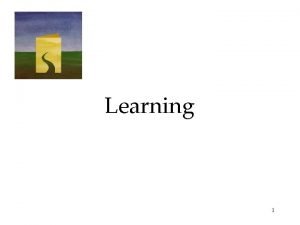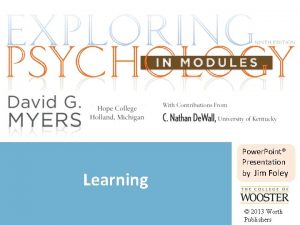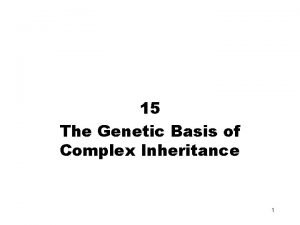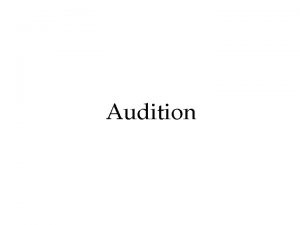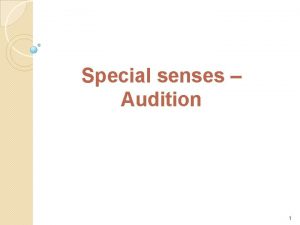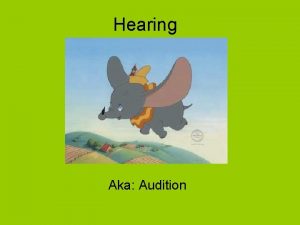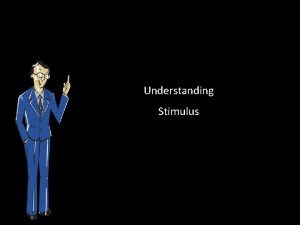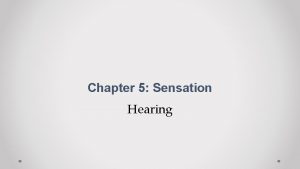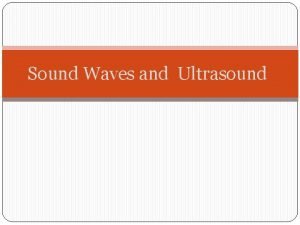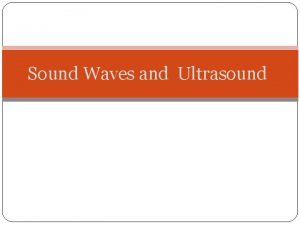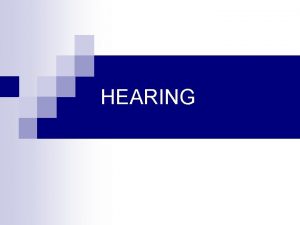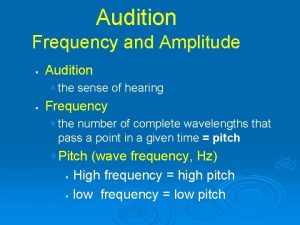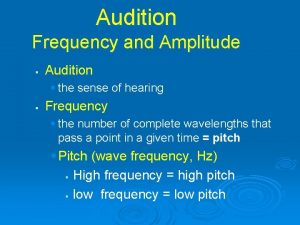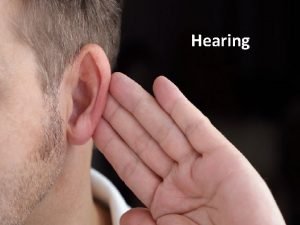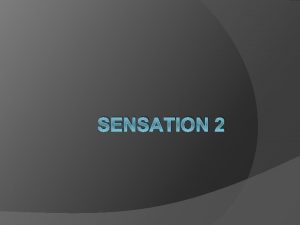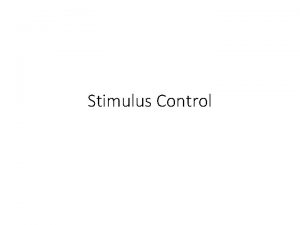Audition the sense of hearing Stimulus sound waves
















- Slides: 16

Audition § the sense of hearing – Stimulus = sound waves (vibrations of molecules traveling in air) • Amplitude (loudness) • Wavelength (pitch) • Purity (timbre)

Frequency • Wavelength described in terms of frequency: measured in cycles per second (Hz) § Frequency § the number of complete wavelengths that pass a point in a given time § Frequency increase = pitch increase § Pitch § a tone’s highness or lowness § depends on frequency § Long waves have low frequency and low pitch § Short waves high frequency and high pitch


The Intensity of Some Common Sounds Decibels are the measuring unit for sound energy


Audition- The Ear § Outer Ear: includes pinna which collects sound, auditory canal which funnels sound to the middle ear

Middle Ear § chamber between eardrum and cochlea containing three tiny bones (hammer, anvil, stirrup) that concentrate the vibrations of the eardrum on the cochlea’s oval window § Ear Drum (tympanic membrane – tight membrane, vibrates with the wave § Hammer, Anvil, Stirrup (Ossicles) – tiny bones that carry vibrations to the inner ear

Inner Ear § innermost part of the ear, containing the cochlea, semicircular canals, and vestibular sacs § Cochlea § coiled, bony, fluid-filled tube in the inner ear through which sound waves trigger nerve impulses


The Auditory Pathway Sound waves vibrate bones of the middle ear Stirrup hits against the oval window of cochlea Sets the fluid inside in motion Hair cells are stimulated with the movement of the basilar membrane • Physical stimulation converted into neural impulses • Sent through the thalamus to the auditory cortex (temporal lobes) • •

Where did that sound come from? • Two cues critical: – Intensity (loudness) – Timing of sounds arriving at each ear • Head as “shadow” or partial sound barrier • Timing differences as small as 1/100, 000 of a second

How We Locate Sounds

Theories of Hearing • Hermann von Helmholtz (1863) – Place theory • Other researchers (Rutherford, 1886) – Frequency theory

Perceiving Pitch § Place Theory – best explains how we sense high pitches § theory that links the pitch we hear with the place where the cochlea’s membrane is stimulated § Frequency Theory – best explains how we sense low pitches § theory that the rate of nerve impulses traveling up the auditory nerve matches the frequency of a tone, thus enabling us to sense its pitch

Hearing Loss § Conduction Hearing Loss § hearing loss caused by damage to the mechanical system that conducts sound waves to the cochlea § Ex: eardrum punctured § Solution? Hearing aids can amplify to help

Hearing Loss § Sensorineural Hearing Loss – more common § hearing loss caused by damage to the cochlea’s receptor cells or to the auditory nerve § Also called nerve deafness § Age, exposure to noise, disease § Solutions? Once damaged, dead – hearing aids amplify to help § Cochlear implants – electronic device that sends signals
 Sound waves longitudinal waves
Sound waves longitudinal waves Sound waves are electromagnetic waves true or false
Sound waves are electromagnetic waves true or false Mechanical waves and electromagnetic waves similarities
Mechanical waves and electromagnetic waves similarities Characteristics of a longitudinal wave
Characteristics of a longitudinal wave Meaning of relatively permanent
Meaning of relatively permanent Associative learning
Associative learning Ap psychology unit 6 learning
Ap psychology unit 6 learning Dominant genetic variance
Dominant genetic variance Narrow sense heritability vs broad sense heritability
Narrow sense heritability vs broad sense heritability Mechanical waves vs electromagnetic waves
Mechanical waves vs electromagnetic waves Mechanical and electromagnetic waves
Mechanical and electromagnetic waves Mechanical wave and electromagnetic wave
Mechanical wave and electromagnetic wave Seismic waves
Seismic waves Mechanical and electromagnetic waves similarities
Mechanical and electromagnetic waves similarities The difference between constructive and destructive waves
The difference between constructive and destructive waves Long waves and short waves
Long waves and short waves Seismic waves are mechanical waves
Seismic waves are mechanical waves




